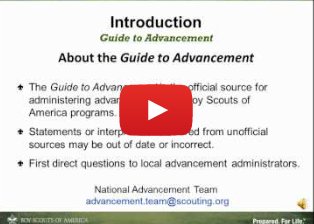 In last week’s article, we listed some of the changes incorporated in the 2013Â Guide to Advancement, the current revision to the comprehensive 2011 edition. Many policies have been tweaked and clarified, and since most of us have become familiar with the 2011 document by now, it’s useful to look at the differences. Here’s a continuation of last week’s look at the changes that impact troops. Continue reading “The 2013 Guide to Advancement, part 2”
In last week’s article, we listed some of the changes incorporated in the 2013Â Guide to Advancement, the current revision to the comprehensive 2011 edition. Many policies have been tweaked and clarified, and since most of us have become familiar with the 2011 document by now, it’s useful to look at the differences. Here’s a continuation of last week’s look at the changes that impact troops. Continue reading “The 2013 Guide to Advancement, part 2”
The 2013 Guide to Advancement, part 1
 The long-awaited 2013 revision to the standard reference text for Scouting’s advancement programs has been released, leaving a somewhat bewildering series of changes and clarifications in its wake.
The long-awaited 2013 revision to the standard reference text for Scouting’s advancement programs has been released, leaving a somewhat bewildering series of changes and clarifications in its wake.
The 2011 document did a great job of consolidating, codifying and clarifying BSA’s rules relating to advancement. The process of creating the work was a careful one involving professionals and volunteers from all regions. The language was carefully chosen to clearly state the various rules, policies and procedures. It became the go-to answer book on all things advancement. Continue reading “The 2013 Guide to Advancement, part 1”
The advancement treadmill
 Of all the attributes we associate with Scouting, certainly the uniform is the most directly visible, but the advancement program is certainly the most palpable (and visible when the insignia of recognition appear on the uniform).
Of all the attributes we associate with Scouting, certainly the uniform is the most directly visible, but the advancement program is certainly the most palpable (and visible when the insignia of recognition appear on the uniform).
Scouting is measured by advancement. Starting in Cub Scouts, den leaders use the advancement program as a roadmap for their den programs. They dutifully plan meetings and activities and lead their dens, checking off requirements in their trail books as they go-see-it, learn about God, country, family and self, and eventually earn badges for learning about community, outdoors, mental, physical and technology skills. In Boy Scouts, there’s a similar list of things to do in order to achieve each rank, and Scouts spend their troop meetings and campouts running down the list and getting signoffs for the things they’ve done. Merit badges follow, each with their own list of requirements to be completed and signed off.
Indeed, to the untrained eye (and many Scouts, Scouters and families too), Scouting is all about completing requirements and advancing. Continue reading “The advancement treadmill”
How Scouting helps identity development
 Last week I attended an orientation session at the university my son is attending in the fall. There were separate sessions for the new students and for the soon-to-be parents of a college kid. Besides the expected talks on dorm life, financial aid and how to pay the bill, several university staffers presented segments on various aspects of adjusting to college life.
Last week I attended an orientation session at the university my son is attending in the fall. There were separate sessions for the new students and for the soon-to-be parents of a college kid. Besides the expected talks on dorm life, financial aid and how to pay the bill, several university staffers presented segments on various aspects of adjusting to college life.
One of the most interesting talks was on the topic of student well-being. Going beyond adjusting to a roommate and using the health center and recreation facilities, the speaker enlightened us on the steps of identity development that our students would most likely go through during their years in college. Continue reading “How Scouting helps identity development”
Advancement educational presentations
 One could argue that uniforming is the most visible of the eight methods of Scouting, even though a lot of boys would rather be invisible while in uniform! The method of advancement, however, certainly has a lot of impact and affects just about every aspect of what we do. Scouts like to advance and earn badges for the things they do. Much of the Scout handbook is devoted to rank advancement requirements and ways to get there.
One could argue that uniforming is the most visible of the eight methods of Scouting, even though a lot of boys would rather be invisible while in uniform! The method of advancement, however, certainly has a lot of impact and affects just about every aspect of what we do. Scouts like to advance and earn badges for the things they do. Much of the Scout handbook is devoted to rank advancement requirements and ways to get there.
To define exactly how advancement is handled, the Boy Scouts of America provides us with an excellent publication, the Guide to Advancement. Issued in 2011, the Guide covers nearly every conceivable aspect to advancement across all programs of the BSA. But one book can’t do the job by itself, so there are supplemental educational presentations that help Scoutmasters, committee members and merit badge counselors navigate the maze of administering the advancement program within the unit. Continue reading “Advancement educational presentations”

